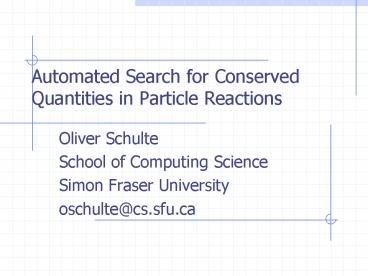Automated Search for Conserved Quantities in Particle Reactions - PowerPoint PPT Presentation
Title:
Automated Search for Conserved Quantities in Particle Reactions
Description:
Kobacas, Valdes-Perez on discovering selection rules. ... Practical use (icing on the cake): analyze data to help with new discoveries. ... – PowerPoint PPT presentation
Number of Views:18
Avg rating:3.0/5.0
Title: Automated Search for Conserved Quantities in Particle Reactions
1
Automated Search for Conserved Quantities in
Particle Reactions
- Oliver Schulte
- School of Computing Science
- Simon Fraser University
- oschulte_at_cs.sfu.ca
2
Outline
- Whats this about?
- Finding conserved quantities in particle
reactions - Algorithm
- Data
- Findings
- Introducing extra particles to fit the data better
3
CS Goals
- Basic research (good enough) Write programs
that match the theories from physics. - Previous work
- Kobacas, Valdes-Perez on discovering selection
rules. - Valdes-Perez, Zytkow on (re)discovering particle
substructure (Physical Review E, 1996) - Practical use (icing on the cake) analyze data
to help with new discoveries.
4
The Goal Find Absolutely Conserved Quantities
- Omnes (1971), Introduction to Particle Physics.
- The method of assigning quantum numbers is
rather lengthy so that we give the procedure in
detail, once and for all. - Want a program for assigning quantum numbers.
5
Basic Principle Disallow as much as you can
- Leon Cooper (1970).
- In the analysis of events among these new
particles, where the forces are unknown and the
dynamical analysis, if they were known, is almost
impossibly difficult, one has tried by observing
what does not happen to find selection rules,
quantum numbers, and thus the symmetries of the
interactions that are relevant. - Kenneth Ford (1965).
- Everything that can happen without violating a
conservation law does happen.
6
How much can we rule out?
Hypothetical Scenario
observed reactions
not yet observed reactions
?- ? ?- n ?- ? m- nm m- ? e- nm ne n ?
e- ne pp p ? p p ?
n ? e- ne
p p ? p p ? ?
cant rule out
7
The Vector Representation for Reactions
- Fix n particles.
- Reaction ? n-vector list net occurrence of each
particle.
8
Conserved Quantities in Vector Space
9
Conserved Quantities are in the Null Space of
Observed Reactions
- Let q be the vector for a quantum number, r for a
reaction. - Then q is conserved in r ? q ? r 0.
- Let Q be a matrix of quantities. Then Qr 0 ? r
is allowed by Q. - So if r1, , rk are allowed, so is any linear
combination .
10
Maximally strict selection rules basis for
nullspace of observations
- Defn A list of selection rules Q is maximally
strict ? nullspace(Q) span(R). - Proposition Q is maximally strict ? span(Q)
R?.
11
System for Finding a Maximally Strict Set of
Selection Rules
- Read in Observed Reactions
from database
Convert to list of vectors R
using conversion utility
Compute basis Q for nullspace R?
Maple function nullspace
12
The Data Particles
- Particles from Review of Particle Physics
- Total 193 particles
- Separate entries for particle and anti-particles
- e.g., p, p 2 entries
- One entry for same type, different masses
- e.g., just one entry for S(1385), S(1670)
13
The Data Reactions
- At least one decay for each particle with a
decay mode. - Particle utility converts to vector
representation.
14
Why Decays?
- Wanted linearly independent reactions.
- Proposition Decays of distinct particles are
linearly independent.
15
independent quantities ? unstable particles
- Defn. A particle is stable if it has no decay
mode, e.g.,
- Proposition Fix n particles, allowed reactions R.
- dim(R?) ? n - unstable particles
- independent conserved quantities ? stable
particles
- e.g. n 193 particles, 11 stable ? ? 11
conserved quantities - because of antiparticles, can be improved to ? 6
conserved quantities
16
Finding 1
- Baryon, E. Charge, Muon, Electron, Tau is
basis for nullspace of possible reactions.
- Output of Program is equivalent classifier to
standard rules. - All absolutely conserved quantum numbers are
linear combinations of Baryon, E. Charge,
Muon, Electron, Tau e.g., Lepton Muon
Electron Tau
17
Finding 2
- Program matches particle-antiparticle pairings.
- There is an analytic explanation.
18
Finding 3
- Different runs seem to produce version of the
lepton family lawse.g., - Muon, - Electron,
-Tau. - No analytic explanation.
19
More Particles can lead to stricter Conservation
Principles
- Well-known example if ?e ?e, then n n ? p
p e- e- should be possible.(Williams
Ch.12.2).
20
When do more particles lead to stricter
Conservation Principles?
- Theorem An extra particle yields stricter
selection rules for a set of reactions R ?there
is a reaction r such that - r is a linear combination of R
- but only with fractional coefficients.
21
Hidden Particles, Finding 1
- The standard selection rules are maximally
strict with respect to transitions among
nonneutrinos.
22
Critical Reaction for ?e ? ?e Discovered by
Computer
Finding if ?e ?e , then the process ? ?0 ? p
e- cannot be ruled out with selection rules.
23
Conclusions
- Program computes maximally strict set of
selection rules. - Good match with Baryon, E. Charge, Muon,
Electron, Tau - Classifies reactions as possible or impossible in
exact agreement. - Reproduces particle-antiparticle pairings
- Extra particle Computes a critical experiment to
test if ?e ?e .
24
Further Work
- Search for partially conserved quantities like
strangeness. - Historical Analysis of Data (R. Coleman).
- Pitch looking for coauthor/proofreader for
interdisciplinary or physics publication.































